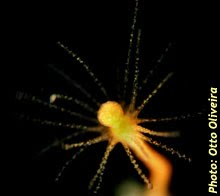Dear Jelly Aficionados:
We are pleased to announce our site http://jellywatch.org.
We've created this page as a resource for monitoring ocean conditions through citizen-supported science.
As we all know, there is a lot of interest in knowing how and whether jellyfish populations are changing around the world. Unfortunately, there are not many data sets with global or continuous coverage. This website attempts to provide beachgoers, divers, boaters, and school groups with an easy means of entering their observations of unusual beach phenomena. Many thousands of eyes are the only way we'll make any headway on this question.
We've tried to make the process of reporting sightings as easy as possible (simply clicking on a map), without downloading anything, e-mailing or calling anyone. This also reduces the need for researchers to enter data by hand, lowering the barriers for the public to report their observations, and for scientists to have to maintain their datasets.
The site we have made is accessible to anyone in the world, and the data that are accumulated can also be freely downloaded by anyone, for use in their research or school projects.
There are many similar sites around the world, but no consistent way that those data are gathered and organized. Some of the existing sites are linked from our regional information page. If you would like to have your site listed here, or if you would rather it was not linked, contact us through the site. We want to make this a community project and draw together many of the overlapping efforts that are underway. If you have your own site and are considering developing a database, you are welcome to use this page as our data entry port.
The page is available in many languages through the use of a Google Translate module.
Anonymous postings are allowed, but do not become public until after approval. For users who sign up for an account, their home location will be saved on the map, and it will be easy to add new reports regularly (for example after a daily beach walk). Registered users can also list their own sightings, and as we get more reports, we'll add a top jellywatchers" section. We especially need "zeroes" -- reports of clean seas where jellyfish or red tides may *not* be present are valuable to reflect changes in ocean health.

We have also created a Facebook fan page to keep people updated on news in the Jellywatch Community.
So encourage your friends and colleagues to report what they see, let your local dive shops, whale watchers, surfers, and aquatic friends know that they can help add to our scientific knowledge.
Improvements and capabilities of the site will be continually added, but for the moment it seemed a good time to get things rolling. We welcome any feedback.
Text by Steven Haddock and Katherine Elliott.






No comments:
Post a Comment